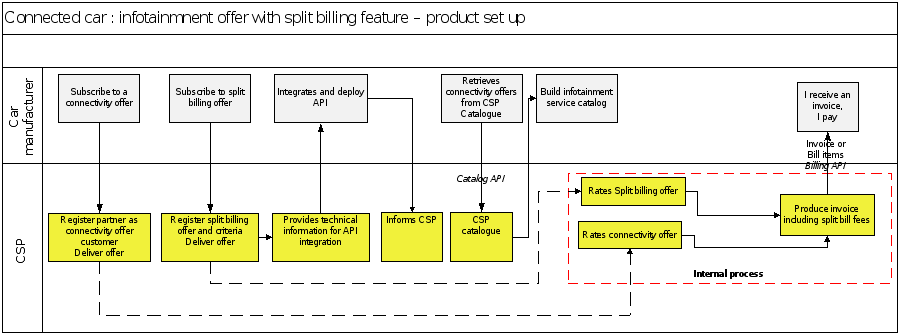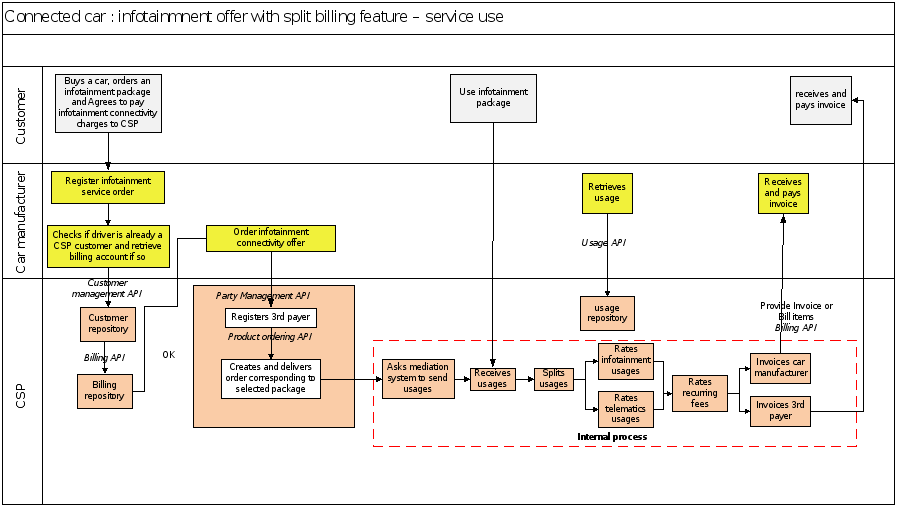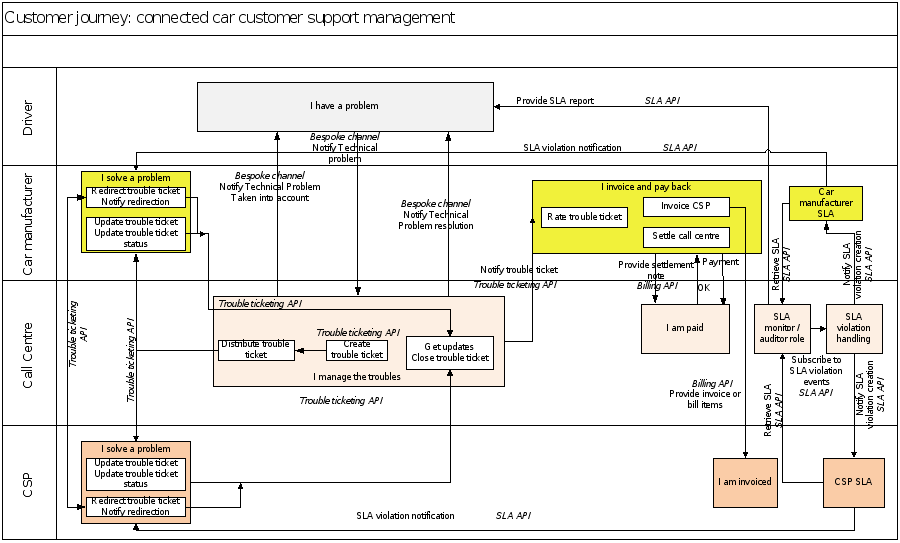Part 1: Product Setup and billing
- Car manufacturer buys from the CSP
- a connectivity offer
- a split billing offer
- CSP provides to car manufacturer all needed technical information to integrate CSP management API (web portal credentials, name of the API bundle corresponding to the subscribed offer),
- Note: an "API bundle" is a set of API (such as Ordering API, billing API etc.) corresponding to the offer subscribed by the partner that it will use to interact with CSP
- The car manufacturer integrates the API with their own IT system and proceeds to their deployment
- The CSP registers the offer subscription in the billing system
- The car manufacturer retrieves the infotainment data connectivity offer from CSP catalog by using catalog management API (probably with some filtering criteria to access only the part of the catalog corresponding to his needs) and builds its own service catalog based on connectivity offers provided.
- A the end of billing period, CSP rates offers fees and produces an invoice including connectivity and split billing fees
- Car manufacturer receives an invoice
- By using Billing API, Car manufacturer can also receive bill items corresponding to its invoice for invoice control or consumption follow up purposes
The diagram below summarizes the sequence of actions
Figure 7 – Connected car product setup and billing
Part 2: Service Use
- When final customer (driver) buys a car, car manufacturer offers them an infotainment service associated with a connectivity service billed by CSP
- Driver selects an infotainment service and agrees to be 3rd party payer for connectivity service as connectivity is not included in infotainment service cost.
- Car manufacturer
- Registers infotainment service order in its own system
- Checks if driver is already a CSP customer by using Customer management API and, if so, retrieves customer billing information by using Billing API
- Orders the infotainment data connectivity CSP offer
- Party API allows car manufacturer to provide CSP with information allowing it to create 3rd payer
- Product ordering API allows car manufacturer to place order for infotainment connectivity package
- CSP creates:
- 3rd party payer,
- Order for infotainment connectivity offer (for advanced offers, it will be possible to detail split billing criteria)
- CSP asks its mediation system to send usage related to the subscription
- Driver uses infotainment service, which generates data usages to bill on infotainment package
- Usage API allows car manufacturer to retrieve usage for consumption follow up purposes
- CSP:
- Splits infotainment usages from telematics usages
- Rates infotainment usages for 3rd payer
- Rates telematics usages for car manufacturer
- At the end of billing period, CSP:
- Rates recurring fees for 3rd payer and car manufacturer
- Produces invoices for car manufacturer and 3rd payer
- By using Billing API, car manufacturer can also receive bill items corresponding to its invoice
The diagram below summarizes the sequence of actions
Figure 8 – Connected car service use
Part 3: trouble ticket management
Note: this part is based on the" Trouble ticketing management in ehealth domain" use case presented within the "ABC of multi-party digital services" catalyst adapted to automotive context.
- The call center manages all technical issues coordinating their resolution either by CSP or car manufacturer
- When receiving a support request from a driver, call center uses Trouble Ticket API to:
- create a trouble ticket
- send trouble ticket to CSP or car manufacturer according to nature of the trouble
- CSP or car manufacturer analyses the trouble and can redirect trouble ticket in case of misdirection by using Trouble ticketing API
- Trouble ticketing API allows also CSP / car manufacturer to update trouble ticket status /information depending on problem resolution progress and to notify updates to call center
- When problem is solved, CSP / car manufacturer uses Trouble ticketing API to send back Trouble Ticket to call center
- Call center informs customer and closes the trouble ticket
- CSP information concerning the trouble tickets is sent to car manufacturer which will use it to calculate the call center settlement note
- Car manufacturer sends settlement note advice to call center by using Billing API
- Call center accepts or disputes the settlement notes
- If call center agrees, CSP pays the settlement notes amount
- Car manufacturer may invoice CSP according to number of trouble tickets related to connectivity issues and send bill items corresponding to invoice by using Billing API
Call center can also play the role of SLA monitor / auditor:
- Call center can subscribe to SLA violation events notification by using SLA management API
- By using SLA management API, Call center can also :
- Provide customer with SLA reports about SLA violation
- Notify SLA violation creation to car manufacturer and CSP
- CSP and car manufacturer can retrieve SLA information by using SLA management API
- Call center can send alarms to teams in charge of problem resolution by using Trouble Ticketing API
- CSP and car manufacturer can notify SLA violation to the team in charge of problem resolution with related metric identifier by using SLA management API
- Teams in charge of problem resolution can correlate alarms with metric identifier
- End of SLA violation resolution process is, then, managed within trouble ticketing process
The diagram below summarizes the sequence of actions:
Figure 9 – Connected car trouble ticket and SLA management
Part 4: Creation and ordering of a new converged infotainment service
Note: this part is based on the" Digital service provisioning in a multi partner context" use case presented within the "ABC of multi-party digital services" catalyst adapted to automotive context.
- Creation of a new converged infotainment service
- The CSP Catalog Manager defines CSP products which are available in central catalog managed by car manufacturer, for inclusion in 'converged' offers:
- CSP Catalog Manager creates a product offering (for example 5 Gb data download for X euros)
- CSP Catalog Manager marks the offer eligible for partners
- By using catalog management API, CSP Catalog Manager sends the product to central catalog so that partners can choose the products to include in their 'converged' offers
- The infotainment content provider (or content aggregator) defines a new converged offer:
- Infotainment content provider creates a new offer (for example access to musical contents)
- By using catalog management API, infotainment content provider retrieves CSP offers from central catalog
- Infotainment content provider creates a new converged offer (for example 5 Gb music download for Y euros)
- By using catalog management API, infotainment content provider can register its new converged offer in central catalog
- By using catalog management API, CSP and car manufacturer can retrieve the infotainment converged offer and verify its correctness
- By using catalog management API, the infotainment converged offer is sent to CSP, infotainment service provider and car manufacturer product catalogs so that customer can order it by using any of the three channels
- The CSP Catalog Manager defines CSP products which are available in central catalog managed by car manufacturer, for inclusion in 'converged' offers:
- Ordering / delivery of the infotainment service
- The customer (driver) places an order for a digital service via car manufacturer self-service portal and car manufacturer registers the order
- Customer management API is used to retrieve customer and customer account
- Billing API is used to retrieve billing account and create it if it doesn't exist
- Product inventory API is used to retrieve existing products (if any) and check compatibility
- Product ordering API is used to create infotainment converged offer order
- Sometimes but generally later, customer requests service activation to infotainment service provider
- By using Product inventory API, infotainment service provider checks if concerned service is owned (has been ordered) by the customer
- If so, infotainment service provider uses Product ordering API to request specific connectivity service activation to CSP
- By using Product ordering API , CSP notifies connectivity service order realization to infotainment service provider
- infotainment service provider activates the service and use product inventory API to notify car manufacturer
- At the end of the billing cycle, car manufacturer:
- produces an invoice for customer
- calculates settlements and uses Billing API to payback infotainment service provider and CSP
- The customer (driver) places an order for a digital service via car manufacturer self-service portal and car manufacturer registers the order
The diagrams below summarize the sequence of actions:
Figure 10 – Connected car creation of a new offer
Figure 11 – Connected car ordering and delivery of a new offer




